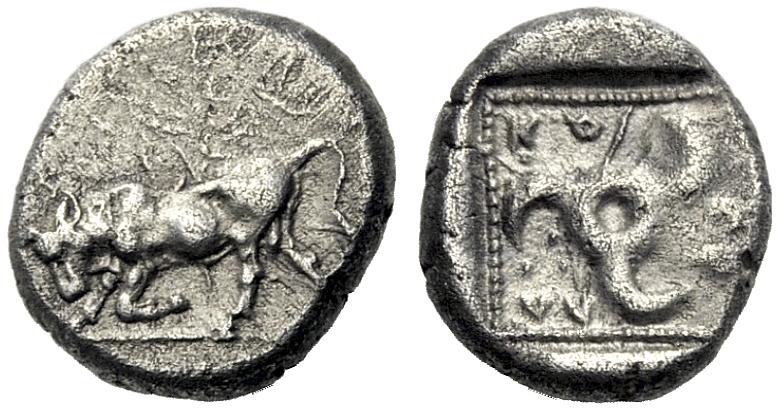Lycia (uncertain mint) (Kuprlli), silver, tetrobols (various types/triskeles) (450-425 BCE)
From SILVER
450 BCE - 425 BCE Silver 10,633 kg
Description
| ObverseInscription or printing placed on the obverse.: | Bull kneeling left |
| ReverseInscription or printing placed on the reverse.: | KO-PP-LL (Lycian).Triskeles and inscription, all within a square beaded border in an incuse square. |
Mint and issuing power
| MintIdentifies the place of manufacture or issue of a numismatic object.: | Lycia (uncertain mint) | Ancient regionAncient region.: | Lycia | Modern countryModern country: Turkey | AuthorityIdentifies the issuing power. The authority can be "pretended" when the name or the portrait of X is on the coin but he/she was not the issuing power. It can also be "uncertain" when there is no mention of X on the coin but he/she was the issuing power according to the historical sources: | Kuprlli (Lycian dynast) |
Chronology
| FromIdentifies the initial date in a range assigned in a numismatic context. | 450 BCE | toIdentifies the final date in a range assigned in a numismatic context.. | 425 BCE | PeriodTime period of the numismatic object.: Classical 480-323 BC |
Physical description
| MetalThe physical material (usually metal) from which an object is made.: | Silver |
Median weightMedian of the weights of numismatic objects (in grams). in grams | 3.90 | DenominationTerm indicating the value of a numismatic object. Examples: tetradrachm, chalkous, denarius.: | tetrobol |
StandardStandard.: |
Image

AC265 kuprlli.jpeg [1]
References
| Die study referencePublication of the study: | Mørkholm - Zahle 19721Mørkholm - Zahle 1972 | ||
| Coin series referenceReference to coin series study: | Sear II2Sear II, n° 5202-5203, RQEMAC3RQEMAC, n° 265 | ||
| Coin series web referenceCoin series web references: | |||
Obverse dies distribution
| FrequencyFrequency of specimen in distribution. ᵖ | Number of obversesNumber of obverse dies. ᵖ (o) | % (o) | Number of coinsNumber of coins. (n) | % (n) | Die nameName(s) of the die(s). |
| 1 | 37 | 55.22 | 37 | 33.33 | 1, 2, 3, 4, 6, 8, 9, 11, 12, 13, 15, 16, 17, 19, 20, 24, 25, 27, 31, 33, 34, 41, 42, 43, 46, 47, 48, 52, 54, 55, 56, 57, 58, 59, 65, 66, 67 |
| 2 | 23 | 34.33 | 46 | 41.44 | 5, 7, 10, 14, 21, 22, 23, 26, 28, 30, 32, 35, 36, 37, 38, 40, 45, 50, 51, 61, 62, 63, 64 |
| 3 | 1 | 1.49 | 3 | 2.7 | 60 |
| 4 | 5 | 7.46 | 20 | 18.02 | 18, 29, 39, 44, 53 |
| 5 | 1 | 1.49 | 5 | 4.5 | 49 |
| Total | 67 of 67 | 99.99 | 111 of 111 | 99.99 |
Reverse dies distribution
no distribution is available
Quantification
| Number of obversesNumber of obverse dies. ᵖ (o) | 67 | Number of singletons (o1)The number of singleton coins. ᵖ | 37 |
| Number of reverse diesNumber of reverse dies. (r) | Number of coinsNumber of coins. (n) | 111 | |
| Coins per obverse dieNumber of coins per obverse die. (n/o) | 1.66 | Coins per reverse dieNumber of coins per reverse die. (n/r) | |
| Reverse per obverse ratioRatio of obverse dies divided by reverse dies. (r/o) | Percentage of singletons (o1)number of coins (n) divided by the number of singletons (o1) ᵖ | 55.22 % | |
| Original number of dies (O) (Carter 1983 formula)The estimation of the number of coins according to Carter 1983 ᵖ | 136.32 | Coins struck if 20,000 as average productivity per dieCoins made if the average productivity for obverses (according to Carter) is 20,000. ᵖ | 2,726,400 |
| Original number of dies (O) (Esty 2011 formula)The estimation of the number of coins according to the singleton formula in Esty 2011 ᵖ (O) | 169.02 | Survival rate if 20,000 as average productivity per dieSurvival rate if average productivity is 20,000. ᵖ | 0.00004 |
| Coverage (o = % of O) (Esty 1984 formula)Esty 1984 - coverage (% of O) ᵖ (o = % of O) | 66.67% | Die productivity if survival rate 1/2,000Average productivity if survival rate is 1/2,000. ᵖ | 1,628.52 |
| Weight of silver (in kg) if 20,000 coins per die (O = Carter formula)Carter 1983 * Median weight * 20000 (*10 if gold or electrum) ᵖ | 10,633 kg <br /> 10,633 kg | Die productivity if survival rate 1/5,000Average productivity if survival rate is 1/5,000. ᵖ | 4,071.3 |
Remarks